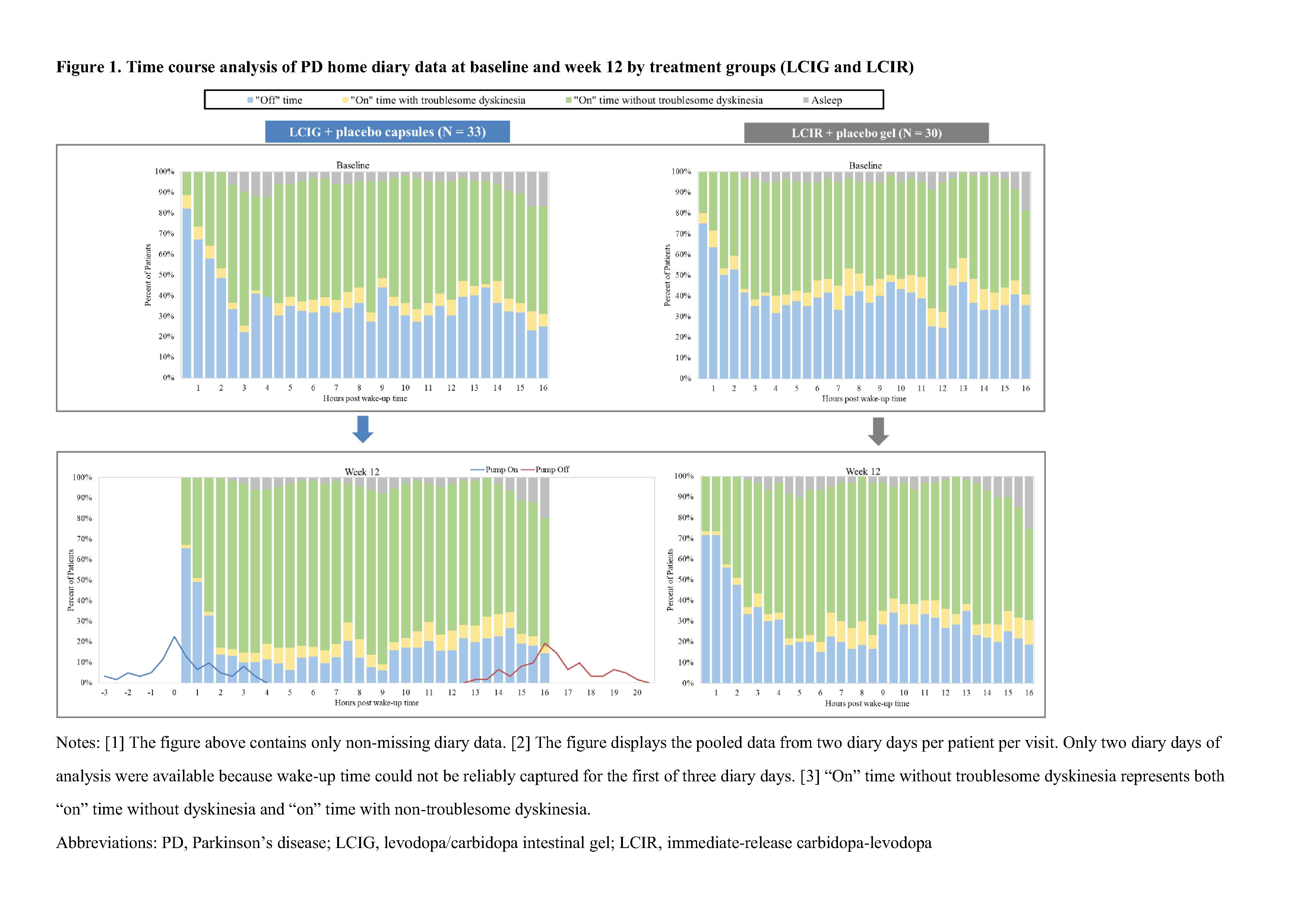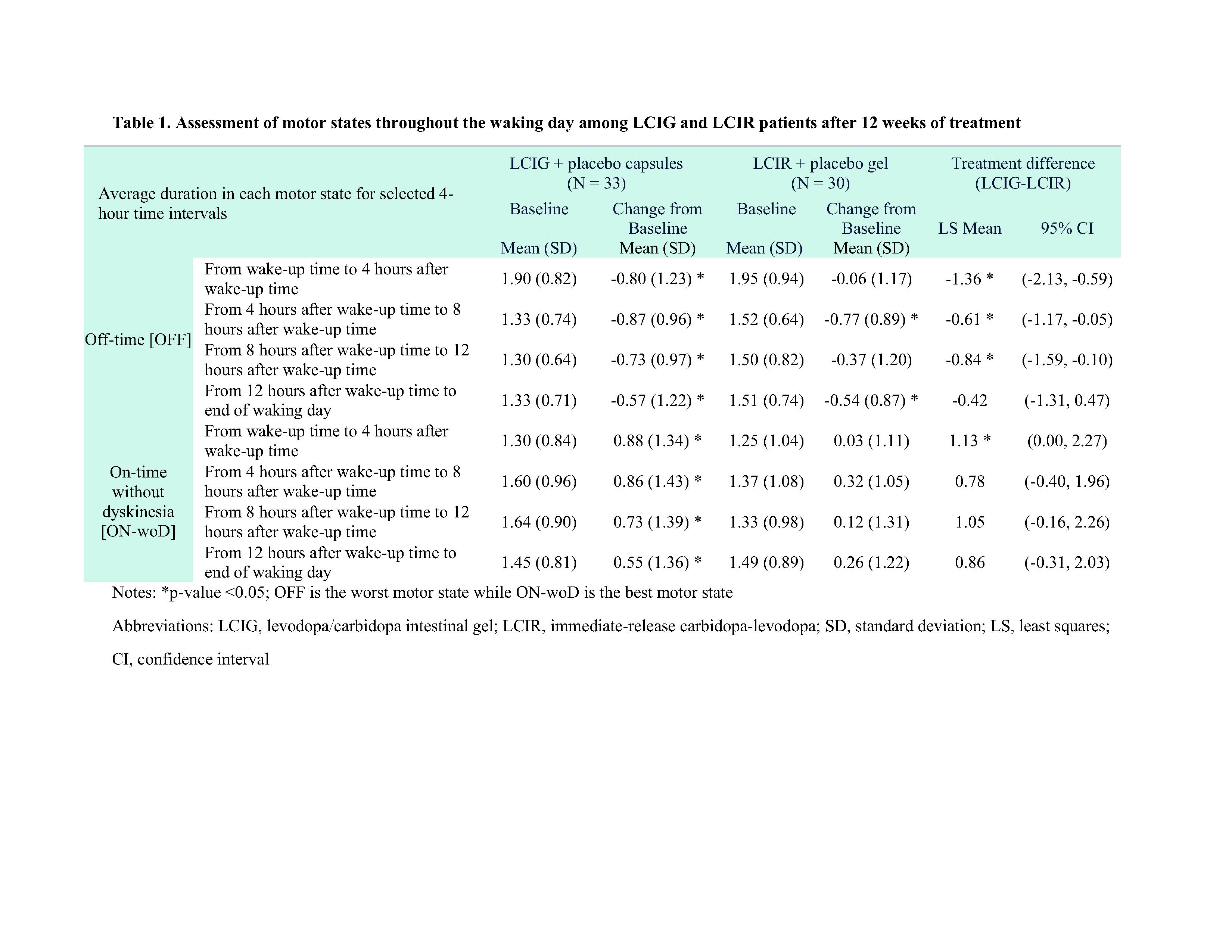Category: Parkinson’s Disease: Clinical Trials
Objective: To assess the speed of on-time onset and characterize the patterns of motor states throughout the day in advanced Parkinson’s disease patients treated with LCIG vs LCIR.
Background: Prior analyses have established LCIG’s greater efficacy in reducing total patient off-time [OFF] relative to LCIR, but the hourly patterns in which these improvements occur throughout the day have not been examined. LCIG’s continuous infusion into the jejunum enables continuous dopaminergic stimulation by rapid, more stable absorption and plasma levels of levodopa than LCIR that may allow better symptom control throughout the day.
Method: Post-hoc analyses were conducted using patient daily diary data from a double-dummy, double-blinded RCT of LCIG vs LCIR that recorded patients’ motor states at 30-min intervals over 3 days each at baseline and 12 weeks post-treatment. Changes in timing of first on-time without troublesome dyskinesia [ON-woTD] post-waking and 4-hourly changes in OFF (worst state) and on-time without dyskinesia [ON-woD] (best state) throughout the 16-hour waking day were assessed within and across treatment groups with Wilcoxon signed-rank tests and ANCOVA models, respectively. Complete diary data were available for 33 LCIG and 30 LCIR patients.
Results: At baseline, 11.3% and 20.0% of LCIG and LCIR patients had ON-woTD within 30-min of waking up, respectively. After treatment at 12 weeks, thrice (32.8%; P<0.05) as many LCIG patients vs similar (26.7%; P=0.39) LCIR patients had ON-woTD within 30-min of wake-up. As patients turned the LCIG pump on, 65.5% of LCIG patients had ON-woTD at 1.5 hours of wake up, while even after 2.5 hours of wake-up, only 61.7% of LCIR achieved ON-woTD [Figure 1]. This effect on ON-woTD was sustained throughout the 16-hour waking day. At week 12, analyses of 4-hourly intervals showed LCIG patients had significant reduction in OFF and significant improvement in ON-woD that were sustained across the 16-hour waking day [Table 1].
Conclusion: LCIG patients experience a more rapid onset of ON-woTD compared to LCIR, which may provide predictability to perform their daily activities without difficulty. LCIG reduces OFF and increases ON-woD consistently throughout the day, thus demonstrating the benefits of continuous dopaminergic stimulation in greater disease control than LCIR.
To cite this abstract in AMA style:
R. Pahwa, J. Aldred, N. Gupta, E. Terasawa, V. Garcia Horton, D. Macaulay, P. Kandukuri, Y. Jalundhwala, Y. Bao, P. Kukreja, S. Isaacson. Rapid on-time onset and sustained improvements in motor states throughout the day following treatment with levodopa/carbidopa intestinal gel (LCIG) vs immediate-release levodopa/carbidopa oral capsules (LCIR) [abstract]. Mov Disord. 2020; 35 (suppl 1). https://www.mdsabstracts.org/abstract/rapid-on-time-onset-and-sustained-improvements-in-motor-states-throughout-the-day-following-treatment-with-levodopa-carbidopa-intestinal-gel-lcig-vs-immediate-release-levodopa-carbidopa-oral-capsule/. Accessed December 23, 2025.« Back to MDS Virtual Congress 2020
MDS Abstracts - https://www.mdsabstracts.org/abstract/rapid-on-time-onset-and-sustained-improvements-in-motor-states-throughout-the-day-following-treatment-with-levodopa-carbidopa-intestinal-gel-lcig-vs-immediate-release-levodopa-carbidopa-oral-capsule/


